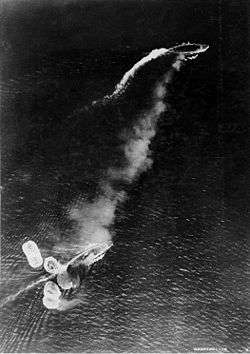Force Z
| Force Z | |
|---|---|
 The loss of HMS Prince of Wales and HMS Repulse, 10 December 1941. Photograph taken from a Japanese aircraft during the initial high-level bombing attack. Repulse, near the bottom of the view, has just been hit by a bomb. | |
| Active | 1941 |
| Country |
|
| Branch |
|
| Size |
2 × capital ships 4 × destroyers |
| Engagements | Sinking of Prince of Wales and Repulse aka Battle off Malaya |
| Commanders | |
| Notable commanders |
Admiral Thomas Phillips (Flag Officer) Captain John Leach (HMS Prince of Wales) Captain William Tennant (HMS Repulse) |
Force Z was a British naval squadron during the Second World War, consisting of the battleship HMS Prince of Wales, the battlecruiser HMS Repulse and accompanying destroyers. Assembled in 1941, the purpose of the group was to reinforce the British colonial garrisons in the Far East and deter Japanese expansion into British possessions, particularly Malaya and Singapore. Lack of aircraft to protect Force Z, underestimation of the Japanese armed forces and the political rather than naval motive for its deployment, are blamed for the destruction of the force.
Composition
Force Z consisted of the battleship HMS Prince of Wales, the battlecruiser HMS Repulse and four modern Home Fleet destroyers, the E-class HMS Electra, Express, Encounter and the J-class HMS Jupiter. For Force Z’s final voyage, the older S-class HMS Tenedos and Great War veteran V-class HMAS Vampire were substituted for the damaged Encounter and Jupiter, who remained in Singapore undergoing repairs.[1] A new aircraft carrier, HMS Indomitable, was to be included but ran aground in the Caribbean during working up trials, HMS Hermes was considered as a replacement but this idea was dismissed as Hermes was too slow.[2]
Origins, Destruction, Vindication
As early as 1920, British Imperial defence strategy had envisaged sending a fleet to Singapore should Far Eastern possessions or interests be threatened.[3] A renamed Force G, Force Z arrived at Singapore on 2 December 1941. It was sent to intercept Japanese landings in Malaya.
Prince of Wales and Repulse were sunk by Japanese air attack on 10 December 1941, becoming the first capital ships under sail to be sunk solely by the action of enemy aircraft in a hostile encounter.
The lack of protective air cover and the resulting loss of large capital ships to hostile aircraft action, were seen as a vindication of authorities on airpower, such as Air Commodore Charles Rumney Samson CMG DSO & BAR AFC, founder of the Royal Naval Air Service, whose papers on the need for air defence at home and in Malaya, Singapore and Hong Kong had not been implemented and US General Billy Mitchell's tactical air combat doctrine. Both men had resigned their commissions due to a failure to adopt a modern policy towards air defence.
See also
Notes
- ↑ Stephen, p. 106.
- ↑ HMS Hermes, British aircraft carrier, WW2, Naval-History.Net, retrieved 2010-01-27
- ↑ Keegan, p.
References
- Hein, David. “Vulnerable: HMS Prince of Wales in 1941.” Journal of Military History 77, no. 3 (July 2013) pp. 955–989. ISSN 0899-3718.
- Hough, Richard The Hunting of Force Z. William Collins, London 1963. OCLC 2699140.
- Keegan, John, ed. Churchill's Generals George Weidenfeld & Nicolson, London, 1991. ISBN 0-8021-1309-5.
- Pitt, Barrie, ed. History of the Second World War Purnell, London, 2nd ed, 1972. OCLC 877588564.
- Stephen, Martin Eric, Gove Sea Battles in close-up: World War 2 Naval Institute Press, Annapolis, 1988. ISBN 0-87021-556-6.